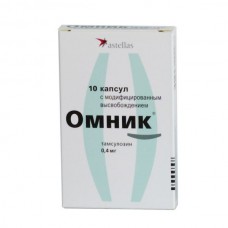Expiration date: 12/2026
Structure and Composition:
Capsules modified release. One capsules contains Tamsulosin hydrochloride 0.4 mg
Excipients: MCC methacrylic acid copolymer (C type) 80 Sodium lauryl sulfate, polysorbate triacetin calcium stearate, talc, gelatin indigotine titanium dioxide, iron oxide, yellow iron oxide red
in blister 10 pcs. in box 1, 3 or 10 blisters.
Description pharmaceutical form:
Hard gelatin capsule size ?2, a body of orange and bears the numbers "701" graphic trademark of cap and olive green with the number "0.4."
The capsules contain granules from white to white with a light yellow tint.
Characteristic:
Specific blocker of postsynaptic adrenoreceptor & alpha1-located in the smooth muscle of the prostate, bladder neck and prostatic urethra.
Pharmacokinetics:
Suction
Tamsulosin is well absorbed in the gut and has almost 100% bioavailability. Absorption of tamsulosin somewhat slowed down after a meal. The same level of absorption can be achieved when the patient receives the drug each time after normal breakfast. Tamsulosin is characterized by linear kinetics. After a single oral 0.4 mg dose of its Cmax in plasma is reached after 6 hours. After repeated oral administration of 0.4 mg per day equilibrium concentration is reached by the 5th day, and its value is about 2/3 higher than the value of this parameter after a single dose.
Distribution
Binding to plasma proteins - 99%, the volume of distribution is small (about 0.2 l / kg).
Metabolism
Tamsulosin is slowly metabolized in the liver with the formation of less active metabolites. Most of tamsulosin in plasma is presented in unmodified form.
The experiment revealed the ability of tamsulosin significantly induce the activity of microsomal liver enzymes.
When mild to moderate degrees of hepatic impairment is not required correction mode.
breeding
Tamsulosin and its metabolites are primarily excreted in the urine, with about 9% of the drug is excreted unchanged form.
T1 / 2 of the drug at a single dose of 0.4 mg after meals is 10 hours, with repeated - 13 hours.
In renal insufficiency, no dose reduction is required, if the patient severe renal insufficiency (Cl creatinine <10 ml / min) the appointment of tamsulosin must be made with caution.
Description of the pharmacological actions:
The blockade of adrenergic & alpha1-tamsulosin reduces the tone of smooth muscles of the prostate, bladder neck and prostatic urethra and improve urine flow. Simultaneously, a decrease symptoms emptying and filling symptoms associated with elevated tone of smooth muscle and detrusor overactivity for benign prostatic hyperplasia.
The ability to influence the tamsulosin & alpha1A-adrenoceptor subtype is 20 times greater than its ability to interact with & alpha1B-adrenoceptor subtype, which are located in vascular smooth muscle. Due to its high selectivity, tamsulosin does not cause a clinically significant reduction in systemic blood pressure in patients with hypertension, and in patients with normal baseline BP.
Indications:
Dysuric disorders in benign prostatic hyperplasia (treatment).
Contraindications:
- hypersensitivity to tamsulosin or any other component of the preparation
- orthostatic hypotension (including history)
- severe hepatic insufficiency.
Be wary - severe renal impairment (Cl creatinine <10 ml / min).
Side effect:
Rarely - dizziness, retrograde ejaculation in rare cases - orthostatic hypotension, tachycardia / palpitations, fatigue, headache.
On the part of the digestive tract: rarely - nausea, vomiting, diarrhea, constipation.
In very rare cases there may be hypersensitivity reactions (rash, pruritus, angioedema).
Drug Interactions:
In appointing the drug Omnic with atenolol, enalapril or nifedipine interactions were found. When applied simultaneously with Omnic cimetidine was a slight increase in the concentration of tamsulosin in blood plasma, furosemide and - lowering the concentration (it does not require changing the dose Omnic as the drug concentration is within the normal range).
Diazepam, propranolol, trichloromethiazide, chlormadinone, amitriptyline, diclofenac, glibenclamide, simvastatin and warfarin does not alter tamsulosin free fraction in human plasma in vitro. In turn, serves as tamsulosin free fractions of diazepam, propranolol, trichlormethiazide and chlormadinone.
In in vitro studies found no interaction at the level of hepatic metabolism with amitriptyline, salbutamol, glibenclamide and finasteride.
Diclofenac and Warfarin may increase the elimination rate of tamsulosin.
Co-administration of other antagonists of alpha1-adrenoceptor & may lead to blood pressure reduction.
Dosage and administration:
Inside. After lunch, drinking water, 1 caps. (0.4 mg), 1 time per day. The capsule is not recommended to chew, because this may affect the release rate of the drug.
Overdose:
No reported cases of acute overdose tamsulosin.
Symptoms: theoretically possible development of acute BP reduction and compensatory tachycardia.
Treatment: the patient in a horizontal position, gastric lavage, the appointment of activated charcoal or osmotic laxative (sodium sulphate) with no effect - the appointment of agents that increase the BCC, if necessary - vasoconstrictor symptomatic therapy. It is necessary to monitor renal function. The effectiveness of dialysis is unlikely.
Special instructions:
As with other alpha1-blockers &, in the treatment of drug Omnic in some cases, decrease in blood pressure may occur, which can sometimes lead to fainting. At the first signs of orthostatic hypotension (dizziness, weakness), the patient should sit or lie down and remain in that position for as long as the symptoms do not disappear. When surgery for cataracts in patients receiving the drug may develop iris syndrome intraoperative instability eyes (narrow pupil syndrome), it is necessary to consider surgery for preoperative patient preparation and conduct of operations.
Before starting Omnic drug therapy, the patient must be examined in order to exclude the presence of other diseases that can cause similar symptoms as benign prostatic hyperplasia. Before you start treatment and regularly during therapy should be performed digital rectal examination and, if necessary, determination of prostate specific antigen (PSA).




